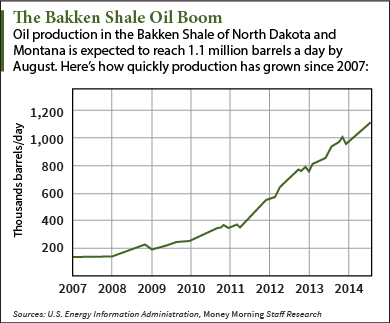The Bakken Shale formation of North Dakota and Montana was back in focus for investors earlier this week when Whiting Petroleum Corp. (NYSE: WLL) announced plans to purchase Kodiak Oil & Gas Corp. (NYSE: KOG).
Through the deal, WLL will pay $3.8 billion in stock and $2.2 billion in debt. The combined company produced over 107,000 barrels of oil equivalent in the first quarter of 2014.
"The new WLL will be the dominant player in the Williston basin, the prime acreage in the Bakken," Money Morning's Global Energy Strategist Dr. Kent Moors said. "That provides the company will significant leverage right in the middle of America's hottest new crude oil production location."
 What makes the merger so important for energy investors is the huge production growth the Bakken is currently experiencing...
What makes the merger so important for energy investors is the huge production growth the Bakken is currently experiencing...
The Bakken Shale Is Still Booming
Oil was first discovered in the Bakken formation in 1953, but production truly blossomed in Montana in 2000 and North Dakota in 2005. That's when drillers began using horizontal drilling and hydraulic fracturing (fracking) techniques.
Production in the Bakken Shale fields has since skyrocketed. In April, combined data from North Dakota and Montana showed that more than 1 billion barrels of crude oil had been produced from the field.
According to the U.S. Energy Information Administration (EIA), production from the Bakken Shale will reach approximately 1,112,000 barrels per day in August.
The majority of the Bakken's production comes from North Dakota, and according to another recent EIA report, oil production in that state alone has grown by 19,000 barrels per day on average over the last three years.
That growth has helped the Bakken become one of the largest U.S. oil plays along with the Eagle Ford Shale in Texas. Together, Texas and North Dakota account for roughly 4 million barrels of oil a day. That's nearly half of the 8.4 million barrels of crude oil produced daily in the United States.
Those plays are major reasons why the United States has surpassed Saudi Arabia and Russia to become the world's largest oil producer. The United States became the world's largest natural gas producer in 2010, but the recent growth in shale oil production has helped the country become the biggest producer of oil and natural gas liquids.
"The U.S. increase in supply is a very meaningful chunk of oil," Bank of America's Head of Commodities Research Francisco Blanch told Bloomberg this month. "The shale boom is playing a key role in the U.S. recovery. If the U.S. didn't have this energy supply, prices at the pump would be completely unaffordable."
That astounding production growth is an extremely bullish sign for oil companies operating in the Bakken - like Whiting Petroleum. And while WLL may now be the biggest Bakken Shale player, there are more companies riding the Bakken's momentum.
Here are the biggest Bakken Shale players capitalizing from this explosive growth...
The Biggest Players in the Bakken Shale
Continental Resources Inc. (NYSE: CLR) operates in both the North Dakota and Montana portions of the Bakken, and as of 2012 owned more than 1.1 million acres of land in the Bakken territory. CLR was a pioneer in the area, having built the first commercially successful well in the North Dakota Bakken that was both horizontally drilled and fractures stimulated.
In the first quarter of 2014, Continental produced more than 97,000 barrels of oil equivalent (BOE) per day from the Bakken, which was an increase of 4% from the previous quarter and 27% from the previous year. In the first quarter, the company operated 20 rigs in the play and expects to operate an average of 21 rigs in the Bakken throughout 2014.
EOG Resources Inc. (NYSE: EOG) is an international oil company that has proved oil reserves in the United States, Canada, Trinidad, the U.K., and China. EOG is the largest player in the Eagle Ford Shale of Texas, but is also a major player in the Bakken.
In its last earnings report, EOG said that it plans to add an extra rig to its Bakken operation in 2014, bringing its total to seven rigs. At the time, EOG reported that each rig in the area could produce between 1,000 and 2,200 barrels of oil per day.
At the start of 2014, EOG controlled approximately 90,000 acres in the Bakken area, and the company is dedicated to increasing production in both the Bakken and Eagle Ford.
"EOG is directing a larger percentage of its 2014 capital budget to the Eagle Ford and Bakken where we have tremendous drilling opportunity with excellent rates of return," Chief Executive Officer William Thomas said. "By increasing activity in these plays, we expect the momentum and operational efficiencies we've created to continue."
Hess Corp. (NYSE: HES) is another major player in the Bakken Shale, though it does have operations all over the world. Hess first began operating in the Bakken in 1957 and has grown its operation there since.
At the beginning of 2014, Hess showed its commitment to the Bakken Shale by announcing that it would be spending 50% of its 2014 exploration and production budget, roughly $2.85 billion, in North Dakota.
Hess already owns a massive amount of land in the Bakken, roughly 640,000 acres. In the third quarter of 2013, Hess was producing nearly 71,000 barrels of oil a day from the region. That was 23% of the company's total production at the time.
Do you invest in companies operating in the Bakken Shale? Join the conversation on Twitter @moneymorning @KyleAndersonMM using #Bakken.
With global energy consumption at an all-time high, and much of the world's economy dependent on oil, the question needs to be asked: Is the world running out of oil?...
Related Articles:


